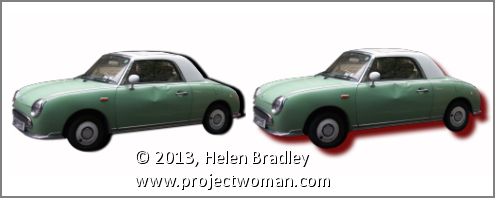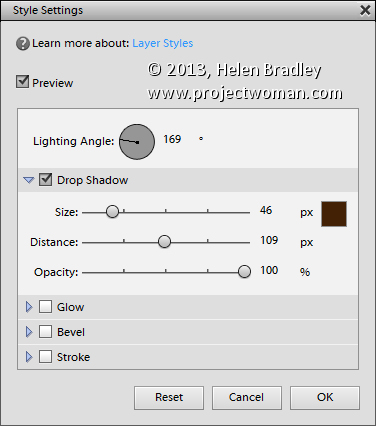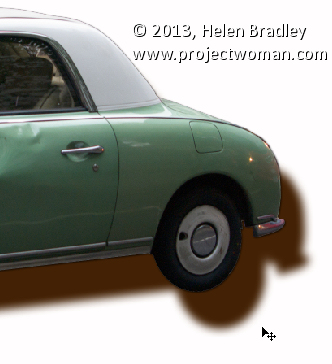How to cut an image from its background – this buckle has hard edges and you will see how to select around it and cut it out using shapes and a mask – you don’t have to learn how to use the pen tool to make the selection (although it would be the better tool to use). The idea with this video is doing it without having to use the pen tool.
Transcript:
Hello, I’m Helen Bradley.
Welcome to this video tutorial. In this tutorial I’m going to show you a method of removing an object’s background when that object has some very distinct edges. Before we get started with this tutorial let’s have a look and see what we are going to do.
A client of mine sent me this image of a buckle. And what we want to do is to extract the buckle from its background so we can do things with it. And this is the finished project that I’ve already created and you can see that now I can create things such as a ribbon running behind the buckle. I’ve added a background to it and it has a slightly dimensional look to it. I’m going to show you how you can do this without even needing to use the Pen tool in Photoshop.
So let’s tuck this out of the way for the moment and let’s consider the image that we’re starting with. When faced with a project like this I’ll always start by duplicating the background layer so I’ll right click the layer, choose Duplicate Layer and click Ok. As a passing comment I would probably rescan this image before I started if I had the actual piece. The image is a little bit fluffy around the edges which is going to make selecting anything a little bit difficult.
And it’s a fairly low res image because this is already at 200 percent so a good scan is a good starting point. But let’s assume that we have a good scan and let’s see how we would get this image or this buckle extracted from its background. I’m going to start by selecting the Elliptical Marquee tool because I’ve really just had a look at this image and said to myself ok what sort of shapes have I got here that I can use to extract the image. And one of them is this curve.
I’ve got a curve here and a curve here and one on the inside and another one here on the inside. They look to me pretty much like circles. I have the Elliptical Marquee tool here and I’m going to start by dragging out an oval shape. And what I’m looking for is something that will be approximately the shape of this outside edge. Now I need to move this so before I let go of the mouse button I’m holding the spacebar and I’m just going to move the shape into position.
And it needs to be a little bit bigger still because what I want to do is to match the outside curve. I’m ignoring absolutely everything else and all I’m seeking to do at this stage is to line this up along this outside curve. Now I’ve got a reasonably good fit for that so I’m going to run with this. I’m also considering here that all the shape, all this buckle is inside this selection so I don’t need to make any adjustments to this selection right now.
All I need to do first off is to create a mask from this. So I’m going to click the Add Layer Mask icon. And what that does when I turn this background layer off is it starts to extract this shape from its background. Now to make it a little bit easier for us to see what we’re doing I’m actually going to put a filled layer in behind the image, it’s this sort of magenta color, so you can see how it’s looking. I’m going back to my image layer and this time I’m going to seek to find a shape for this side. So, again, I’m going to draw my large oval.
I’m going to hold the spacebar so I can move it into position, let go of the spacebar, reshape the circle and just keep going with the spacebar and moving it but without letting go of that mouse button until I have got the shape that I want for this long edge of the buckle. Now we do have a light problem here that we’ll need to adjust for because what I would typically do is to select Inverse so that now I have selected everything that was not selected earlier and then I would fill it because I would target the mask and fill it with black.
The problem is that I’m now cutting off this edge of the buckle. So I don’t want to do that. I’m going to do Edit, Undo Fill and I’m going to again invert that mask so that we’ve just got this circle shape. To make sure that I don’t remove part of the buckle that I already have extracted I’ve selected the Rectangular Marquee tool here and I’m going to select the Add to Selection icon here. And I’m just going to add back in anything that was on this side of the buckle so that now my shape is this curve and everything over here.
Now when I choose Select Inverse the only area that is selected is this edge down here, exactly what I want to mask. I’ll target my mask and press Alt Backspace to fill it with the current foreground color which is black. And you can see that we’re powering along here. We’ve got two sides of this shape pretty near extracted. I’m going back to the Elliptical Marquee tool because this looks like the side of an oval to me. Again, I’m going to create my oval shape and push it into position, maybe shrink it down a little bit to get it a little bit more curvy.
And when I have it in position I’m going to let go the mouse button and again here I’m going to need to add some extra bits of the image here because I don’t want to remove them. So, again, I’m going to target the Rectangular Marquee tool and add to this selection. So right now my selection is this shape. I’m going to invert it, select Inverse so that the only thing selected is across the top here, the area that we no longer want, target the mask and Alt Backspace to fill it with black. And I’m going to continue at the bottom here.
Again, Elliptical Marquee tool, a flat sort of oval shape, move it into position, size it. Any time I want to move it I’m just holding the spacebar so I can move it a little bit more accurately. When I’ve got it into position I’m going to select the Rectangular Marquee tool to add to the section so that we don’t lose the shape that we’ve already extracted, select Inverse and make sure I have my mask targeted, Alt Backspace to fill my mask with black.
At this point I might go back and reform these sides. I think I’ve got most of what I want out but I may want to perfect them a little bit more. I’m not going to bother doing that now, but you can see that you can continue to work on that side if you want to. I’m going to have a look at these inner areas. And the inner area again is just another curve. And I can make that curve using the Elliptical Marquee tool. Now I’ve let go of my shape so rather than discard it completely I’m going to choose Transform, Selection and just move it into position. And I can nudge it with my arrow keys.
When I’ve got it pretty much where I want it to be I’ll click the checkmark. Now I’m going to again select the Rectangular Marquee tool but this time I only want to select this inside bit so what I want to do is to drag over this and take the intersection of the two shapes. So I’m going to click this option here and then I’m going to be really careful about locating the bit I want to select and I’m just going to drag over it. And this is going to give me the intersection of these two edges.
Now I’ve got a little bit of a problem here so I’ll probably just take the Lasso tool, hit the minus key and just lasso into the corner to just round off that corner. If I’m happy with the shape I can now click on my mask and Alt Backspace, Option Delete on the Mac, to again take that piece out of the mask. Now there’s a good chance that this shape is the save as this shape just mirrored. So let’s choose Select, Transform Selection. This time I’m going to transform the selection’s width to minus 100 percent which will flip it over and then I’m going to move it into position.
When I have it in position I’m going to click the checkmark here, target the mask, Alt Backspace, Option Delete on the Mac, to create the filled mask object. Now that I’ve done this let’s assume that we have a good selection. I’ve been working pretty quickly here so I think I could probably have done an even better job had I been a little bit slower. I’m going to right click and duplicate this layer entirely so I have a second layer with its mask.
Now I’m going to trash that mask and I want to delete it. I don’t want this layer to have a mask at all. So I’m going to turn that off. I’m going back to this mask here. This is my good mask and I’m going to Alt click on the mask. And what that does is it shows me the mask itself. I’m now going to click on the Quick Select tool and I’m going to select the mask. I just want the white area selected. Now I’m going to turn off this layer and return to this top layer.
I’m going to turn everything else off. With the top layer selected I’m now going to use this tool that is new in Photoshop CS5, Select, Refine Edge. If you’re using an earlier version of Photoshop you’ll go into Modify and then you could expand or contract the border or add a little bit of a feather to it to soften it. In Refine Edge we get to refine the edge by looking at the background.
At the moment I have it against white so I can see what my edges are going to be like. I’ve seemed to have lost that so let’s go back and get Refine Edge. Here what I’m going to do is to smooth it out a little bit. I’m going to feather it a little bit and I can even shift the edge. So what I’m looking for is a good selection here. I’ve used my original mask that I created using the shape tools but I’m actually perfecting it now using this Refine Edge tool or we could perfect it with adding a slight feather to it or contracting or expanding it using the tools that were available in earlier versions of Photoshop.
Once you’ve perfected the edge I’m going to click Ok because I have its output to a selection. This is my new selection. I’m going to add a layer mask to this layer. So this is a little bit better selection than I had before. You can see that this new version is a little bit better than the last. Now to work on this image a little bit more I might want to add a little bit of a bevel to it so I’m going to add a layer style. I’m going to choose Bevel and Emboss. I don’t want to emboss it and I don’t want a shadow at this stage but what I might want is a little bit of a bevel just a slight rounding of the edges.
And you can fiddle here in this dialog to see exactly what you can achieve for the shape that you’re working on. But I might come in here and have a look at that as an option. I may also want to add a drop shadow to this shape in which case I’ll go to the Drop Shadow tool here and I can drag out and create a drop shadow for the object. You can also add a pattern overlay. Now it’s possible to add a pattern overlay in a number of different ways but since we’re already in this layer style dialog we’re going to use this as our pattern overlay.
I’m going to click here and go and select a pattern. Now I have a stripped pattern here that I created a long time ago. Now the pattern is sort of ok but I wanted lots of stripes not just a few of them so I’m going to scale it right down. And we can blend it in if we want to. So if you’ve got a shape that you want to start blending and using some of the detail or some of the shading on the layer below you can do that here using these blend modes. I’m not going to do that. I’m just going to add it in normal mode here and I’m just going to click Ok.
So there’s my shape and now I can do things like test it on a background to see if it is as I want it to look. And I can save it out now as a png file with some transparency. If you want to sharpen up these edges these edges would sharpen up a bit if this object were rescanned. But you can also sharpen edges by choosing Filter and then Sharpen and then Sharpen Edges. Now this filter just sharpens edges. There’s no settings for it but you can run it a couple of times if you need to so you could sharpen the edges just a little bit more. That might give you a slightly better effect.
So there is a handy way of extracting an object from its background when the object has some hard edges and where you can see visually that you’ve got some shapes on that object that you could use to make the extraction a whole lot easier.
I’m Helen Bradley.
Thank you for joining me for this video tutorial. Look out for more of my tutorials on this YouTube channel and please consider subscribing to the channel so you’ll be alerted when new videos are released. Visit my website at projectwoman.com for more tips, tricks and tutorials on Photoshop, Illustrator, Lightroom and a whole lot more.




